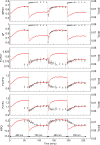Demonstration of a relationship between state transitions and photosynthetic efficiency in a higher plant
- PMID: 31694051
- PMCID: PMC6854431
- DOI: 10.1042/BCJ20190576
Demonstration of a relationship between state transitions and photosynthetic efficiency in a higher plant
Abstract
A consequence of the series configuration of PSI and PSII is that imbalanced excitation of the photosystems leads to a reduction in linear electron transport and a drop in photosynthetic efficiency. Achieving balanced excitation is complicated by the distinct nature of the photosystems, which differ in composition, absorption spectra, and intrinsic efficiency, and by a spectrally variable natural environment. The existence of long- and short-term mechanisms that tune the photosynthetic apparatus and redistribute excitation energy between the photosystems highlights the importance of maintaining balanced excitation. In the short term, state transitions help restore balance through adjustments which, though not fully characterised, are observable using fluorescence techniques. Upon initiation of a state transition in algae and cyanobacteria, increases in photosynthetic efficiency are observable. However, while higher plants show fluorescence signatures associated with state transitions, no correlation between a state transition and photosynthetic efficiency has been demonstrated. In the present study, state 1 and state 2 were alternately induced in tomato leaves by illuminating leaves produced under artificial sun and shade spectra with a sequence of irradiances extreme in terms of PSI or PSII overexcitation. Light-use efficiency increased in both leaf types during transition from one state to the other with remarkably similar kinetics to that of F'm/Fm, F'o/Fo, and, during the PSII-overexciting irradiance, ΦPSII and qP. We have provided compelling evidence for the first time of a correlation between photosynthetic efficiency and state transitions in a higher plant. The importance of this relationship in natural ecophysiological contexts remains to be elucidated.
Keywords: light-use efficiency; photosynthesis; photosystems; state transitions.
© 2019 The Author(s).
Conflict of interest statement
The Authors declare that there are no competing interests associated with the manuscript.
Figures










References
-
- Pfündel E. (1998) Estimating the contribution of photosystem I to total leaf chlorophyll fluorescence. Photosynth. Res. 56, 185–195 10.1023/A:1006032804606 - DOI
-
- Holmes M.G. and Smith H. (1977) The function of phytochrome in the natural environment—I. Characterization of daylight for studies in photomorphogenesis and photoperiodism. Photochem. Photobiol. 25, 533–538 10.1111/j.1751-1097.1977.tb09124.x - DOI
Publication types
MeSH terms
Substances
LinkOut - more resources
Full Text Sources

